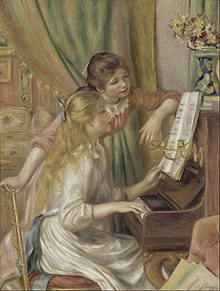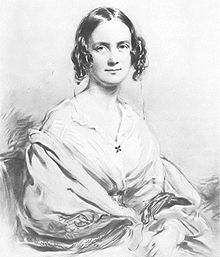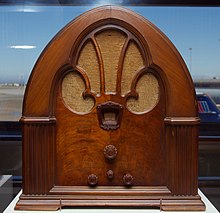Social history of the piano
The social history of the piano is a historical consideration of the instrument's role in society . The piano was invented at the end of the 17th century and established itself in Western society from the end of the 18th century.

Early years
Developed around 1700 by Bartolomeo Cristofori for his wealthy employer Ferdinando de 'Medici , the piano was a spectacular innovation. For the first time, loud and soft tones could be realized on a keyboard instrument by means of a different force of attack . It was extremely expensive to purchase and maintain . For some time after its invention, the piano was only owned by kings (for example from Portugal and Prussia ) (see main article Hammerklavier ) . Even during the 18th and early 19th centuries, pianos were beyond the financial reach of the average household and the pianos of that time were generally owned by the nobility and aristocracy.
Pianos and women
Both Parakilas and Loesser emphasize the connection between pianos and women. Obviously, taking piano lessons was more common for girls than for boys. It was also widely accepted that the ability to play the piano made young women desirable as wives.
Women who learned to play the piano as children often kept doing it as adults, bringing music into their homes. For example, Emma Wedgwood (1808-1896), the granddaughter of the wealthy industrialist Josiah Wedgwood , took piano lessons from none other than Frédéric Chopin and apparently achieved a good level of artistry. After marrying Charles Darwin , Emma continued to play the piano every day while her husband enjoyed listening to her.
A number of female piano students became virtuosos, and the skills of female piano players inspired the works of Haydn , Mozart and Beethoven , all of whom dedicated difficult-to-play piano pieces to their friends. However, careers as concert musicians were typically only open to men - an important exception later was Clara Schumann .
Spread of the piano
During the nineteenth and twentieth centuries the middle class grew in both numbers and economic means. This rise found a parallel in the increased importance of domestic piano music as more and more people were able to buy pianos and piano lessons. The piano also became common in community settings such as schools, hotels, and public halls. In the course of the expansion of the western lifestyle in other parts of the world, pianos became more and more common there, for example in Japan.
In order to understand the rise of the piano in the middle class, it helps to realize that before the introduction of records and radios, making music was part of everyday life even for "normal" people. In particular, folk music developed in the working classes that was passed down orally and sung by everyone. Joseph Haydn's parents (1732–1809) could not read music, but Haydn's father Mathias (who worked as a wheelwright ) taught him to play the harp, and the Haydn family often played and sang together. With increasing prosperity, more and more people were able to afford pianos and adapted their domestic musical skills accordingly to the new instrument; the piano became an important source of music in households.
Amateur pianists often emulated the leading pianists and composers. Professional virtuosos described methods of learning to play the piano in books that sold well. The virtuosos also prepared their own editions of classical music, detailing the tempo and expression, to guide the amateurs who wanted to emulate their playing. (Nowadays students are often encouraged to work from an Urtext .) The piano compositions of great composers often sold well among amateurs, despite the fact that - starting with Beethoven - they were often far too difficult for anyone but highly trained talents to to be played perfectly. Apparently, amateurs took pleasure in trying to get as close as possible to the great role models, even if they ultimately failed to play a piece flawlessly from start to finish.
A favored form of piano playing was four-handed play, in which two pianists sit side by side at a single piano. These works were often arrangements of orchestral works and, in the time before technical possibilities arose, to record music, to spread knowledge and to rehearse new orchestral pieces, even if an orchestra was not present on site. Sometimes another instrument was played with the piano or sung with the piano.
Parents whose children showed unusual talent often pushed them into professional careers and sometimes threw themselves deep into debt in order to make the education possible. Artur Schnabel's book My Life and Music paints a vivid picture of his own experiences based on these conditions, which were found in Austria-Hungary at the end of the 19th century.
20th century
The status of the piano in families remained unchanged until advances in technology made it possible to enjoy music in a passive form. First the " electric piano " (from around 1900), then the phonograph (which became common property in the decade before the First World War ), then the radio in the 1920s triggered a great decline in amateur piano playing as a domestic recreational activity. During the Great Recession in the 1930s, piano sales plummeted and many manufacturers went out of business.
In the second half of the 20th century. were spread keyboards , electric pianos and music software , which vary enables digital piano pieces. Piano music has also found widespread use through modern music studios and popular classical music .
literature
- Arthur Loesser: Men, Women, and Pianos . 1954 (reissued by Dover Publications).
- James Parakilas: Piano Roles: Three hundred years of life with the piano . New: Yale University Press, Haven CT 1999.
- Gretchen Wheelock: The Classical Repertory Revisited: Instruments, players, and styles. In Parakilas 1999, pp. 109-131.
Individual evidence
- ↑ Parakilas (1999, 96-109)
- ↑ Loesser (1954)
- ^ Wheelock (1999, 117)
- ↑ Parakilas (1999, 102)
- ↑ Wheelock (1999, 116) notes that, with one exception, the recipients of Haydn's piano works were all women. The exception is the first publication, the sonatas from 1744, which are dedicated to his employer, Prince Nikolaus Esterházy .
- ↑ This point is worked out by Loesser (1954) in various places.
- ↑ Reprinted 1988; Mineola, NY: Dover Publications.


